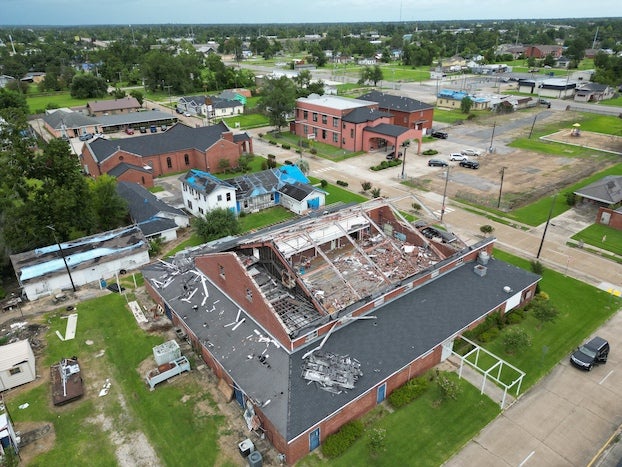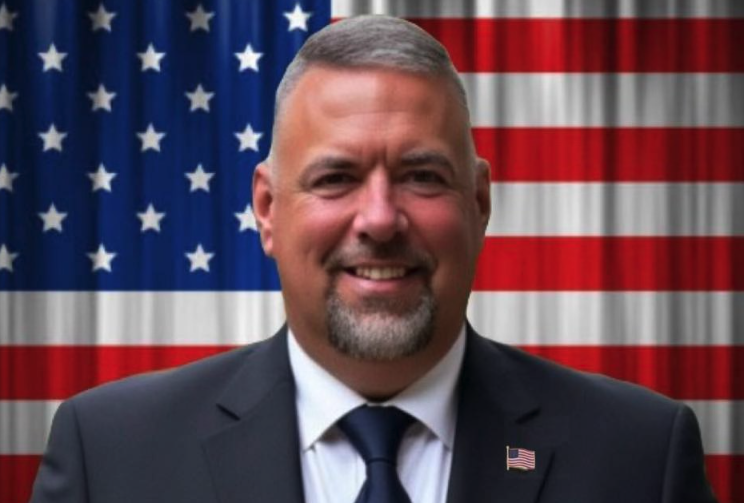Bishop: Recovery decisions made at the church parish level
Published 5:54 am Monday, August 22, 2022

- An aerial photo of Sacred Heart Catholic Church in Lake Charles shows destruction remains nearly two years after Hurricane Laura devastated Southwest Louisiana. (Reader-submitted photo)
Editor’s Note: This is the second in a four-part series from an exclusive interview with Bishop Glen John Provost of the Diocese of Lake Charles addressing claims of neglect at Southwest Louisiana churches.
According to the Diocese of Lake Charles, repairs made to the parish buildings are determined by “the needs of the church at that time” and are led by the pastors, not the Diocese.
This understanding has proved to be of prime importance in light of the recent heat the Diocese of Lake Charles is receiving. After a series of letters to the editor criticizing the Diocese’s handling of hurricane recovery, and claims of racially discriminating against predominately Black parishes, Bishop Glen John Provost aims to provide transparency for these processes.
Trending
The Diocese of Lake Charles faced “damage and destruction to over 400 various buildings, valued at over $100 million,” Provost said. “Recovery will be lengthy and require patience and hard work. Recovery for this reason is a cooperative effort between the parishes, their pastors and provisioners, and the Diocese, which oversees the recovery.
“Everybody’s in the same boat. This is what I’m afraid the writers of those letters don’t understand,” he said. “Everyone is frustrated. Everyone is anxious. Everyone is impatient. But they have to know what’s going on. That helps them to understand.”
He said the decisions regarding the recovery process of church facilities are made on the church parish level. “They must set the priorities for rebuilding. They must decide what they want, to rebuild, to replace, to repair, or not.”
According to Provost, the Diocese coordinates the efforts of the individual parishes, and plays the role of “broker” for funding, construction, and repairs. He emphasized that all funding comes from four primary sources: insurance, FEMA, charitable donations and parish funds.
“The Diocese hires the consultant, ensures the accuracy of the recovery projects, and acts for the parishes in negotiation with insurance companies and government agencies,” he said. “This frees the parish to do what they’re supposed to do.
“The Diocese does all of this as a service to the parishes, but with the full knowledge of the parishes in the person of each pastor who is expected to communicate developments to his parishioners.”
Trending
For Provost, deciding priority is dependent on necessity. “Destroyed buildings are a priority. However, a parish may decide not to rebuild or to replace or to rebuild and relocate.”
According to the Diocese “this included reviewing the use of buildings before the hurricanes so that, for example, buildings not used before the hurricanes would not be repaired because they were not being used prior to the storm, and the financial situation of the church.”
He also said delays can happen for a variety of reasons, including environmental issues, funding, legal questions, delays in delivery of construction material, and fulfilling government regulations for FEMA and other agencies. Personnel issues, such as a change in pastor, can also delay recovery efforts.
Dr. Wendell Ross Sr. wrote a letter to the American Press expressing his frustration with what he claims to be a lack of communication from the Diocese regarding the demolition of historic Black facilities on Sacred Heart’s grounds. This frustration has led to accusations of a “systematic planned erasing” of Sacred Heart’s historical Black parish.
Provost denies these accusations.
“We have extended to it the same attention and courtesies that we’ve attended and extended to any of the other parishes that we have dealt with,” he said.
He said “the same processes used in every parish are the same processes that would take place at Sacred Heart of Jesus.”
Ross referenced repairs at predominantly white parishes such as Saint Margaret, Our Lady Queen of Heaven, Immaculate Conception and Saint Louis.
In response, Provost listed other African American parishes that had been under recovery.
“We have more than just one African American parish,” he said. “Immaculate Heart of Mary is finished with its repairs. We are also addressing St. Joseph’s in Welsh, Our Lady of Perpetual Help in Jennings is another parish. St. Joseph’s in Elton is another African American parish.”
“St. Henry’s, while not an African American parish historically, has a significant African American parishioner base. So we have addressed that, as well, in the mission. St. Peter Klaver in Iowa is one, as well.”
$907,845.16 has been spent by the Diocese at Sacred Heart of Jesus. The parish of Sacred Heart contributed $1,200 for repairs.
The Rev. Jeffrey Starkovich, diocesan spokesperson and pastor of St. Pius X Catholic Church in Ragley, said Sacred Heart of Jesus in Lake Charles has had the roofs of all surviving structures repaired.
In regards to non-surviving structures, the Diocese of Lake Charles was given notice by the city of Lake Charles in June that the failure to remove the gym in its dilapidated condition would result in a daily fine. This notice was given because of environmental concerns.
This month, plans were submitted to the City Council to demolish the gym and old rectory.
The Diocese of Lake Charles provided information regarding the repairs made within various parishes and the funding spent on these repairs.
The reopening of schools was a priority for the Diocese of Lake Charles, resulting in a high amount of funding that was streamlined to repair these facilities. Saint Margaret Catholic School spent a total of $3,504,286.95. FEMA obligated $2,241,632.10.
High repair costs at Saint Margaret Catholic School are attributed to compounded losses due to the mismanagement of the company responsible for mitigation. Legal recourse is being pursued.
Saint Louis High School underwent major repairs. As a result, a temporary campus was established.
“After assessment, the Board of Pastors and school administration requested that the school relocate to the Morganfield area,” Starkovich said. “This was approved with the stipulation that the school finance the total rebuilding effort, including the purchase of the new property and the architectural plans for the new school.” No diocesan funds have been used for the Morganfield site.
The Diocese of Lake Charles has spent $5,649,129.08 at Saint Louis. $3,66,992.14 of this was obligated by FEMA, while $231,000 was financed by Saint Louis.
Our Lady Queen of Heaven Parish had roof and windows that were damaged as a result of the hurricanes and were replaced. The parish did choose to pay for non-hurricane-related repairs. Some were planned before the hurricanes made landfall. The Diocese of Lake Charles spent $1,352,952.40, with $21,693.40 being financed by OLQH.
The Cathedral of Immaculate Conception repaired broken windows, replaced fences, and repaired sewage backup. $1,136,854.40 was spent by the Diocese. $354,379.35 was financed by ICCS.
The Diocese also provided information regarding demolition in other parishes.
“Numerous buildings throughout the Diocese of Lake Charles and its parishes sustained significant damage,” Starkovich said. The provided buildings “have been demolished, are scheduled for demolition, or are in consideration to be demolished following a final demolition.” These plans are also subject to change.
Immaculate Conception, Jennings were forced to demolish The Immaculata Center, which was the historic Immaculate Conception school, and housed their CCD classroom. The facility was damaged beyond repair.
St. Theodore in Moss Bluff already demolished their adoration chapel and rectory, and have plans to demolish their youth house and enrichment center. The enrichment center is the historic church.
Christ the King in Lake Charles has decided to demolish their hall and office building. The demolition of the church is being considered.
Our Lady Queen of Heaven will be selling the Crossroads Bookstore as is, while the Knights of Columbus Parish Hall will either be sold as is or demolished.
Saint Martin de Porres Parish in Lake Charles might be facing the demolition of their Granger Vincent Complex. The FEMA declaration is pending.
St. Henry in Lake Charles has decided to demolish their original church hall and old rectory. St. John Bosco in Westlake has also decided to demolish their old rectory.
The CCD classroom and church office of St. Pius X in Ragley will be demolished, as will the Former Vianney House of Discernment at Saint Louis high School.
Lastly, the Diocesan property on Kirby Street is scheduled for demolition.
“I think it needs to be said that each parish is unique,” Provost said. “Both in its damages, and by its nature. So, Sacred Heart is unique.”
“We know we’re all suffering together,” Starkovich said. “We’re all dealing with loss and lots of loss and the recovery is slow. That’s what we’re hoping to encourage … that the pastor with his people comes together with the Diocese to encourage these projects, and even at Sacred Heart in Lake Charles. We’d love to see everything be rebuilt and flourish and be a great community to the legacy of Katharine Drexel, and to see North Lake Charles, grow.”




